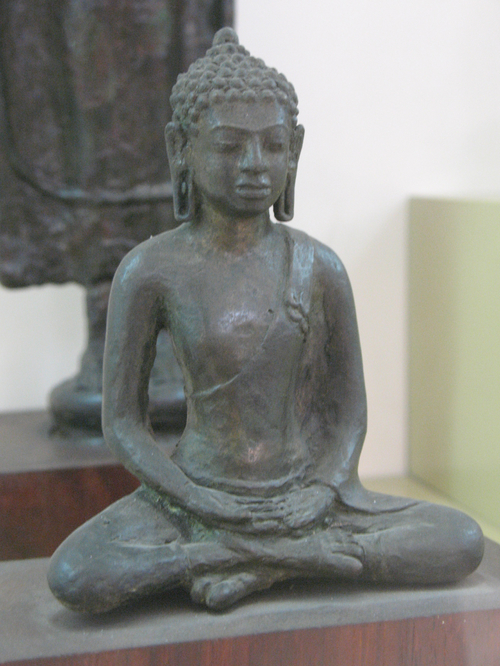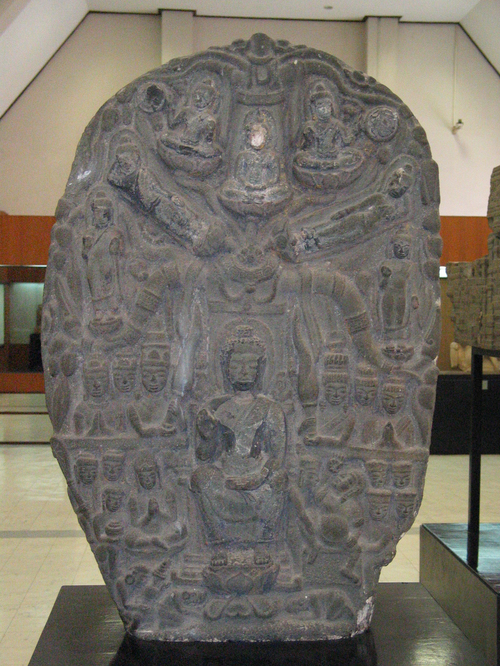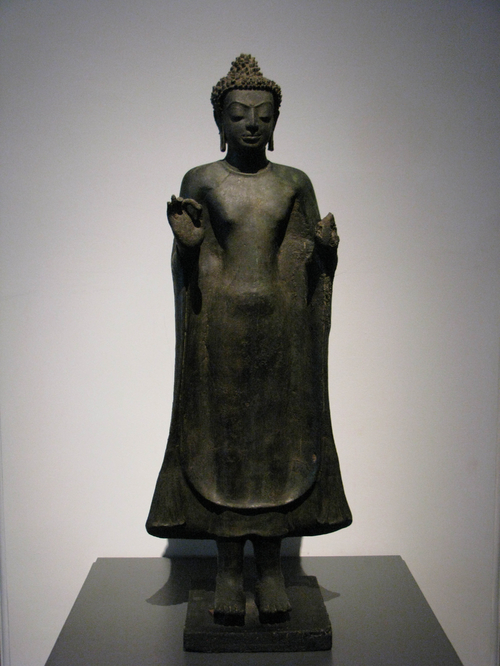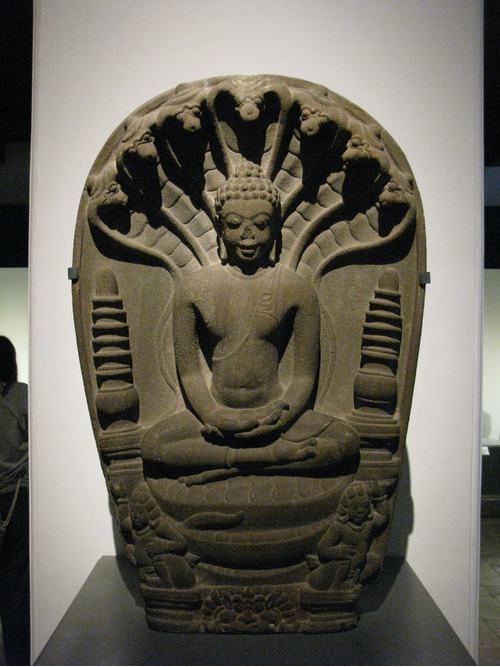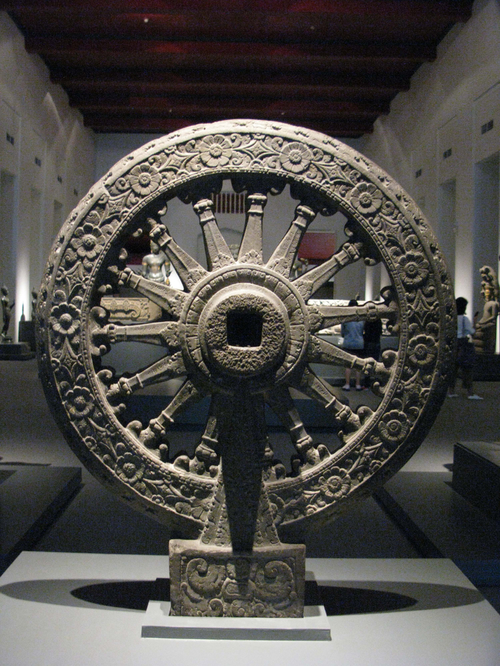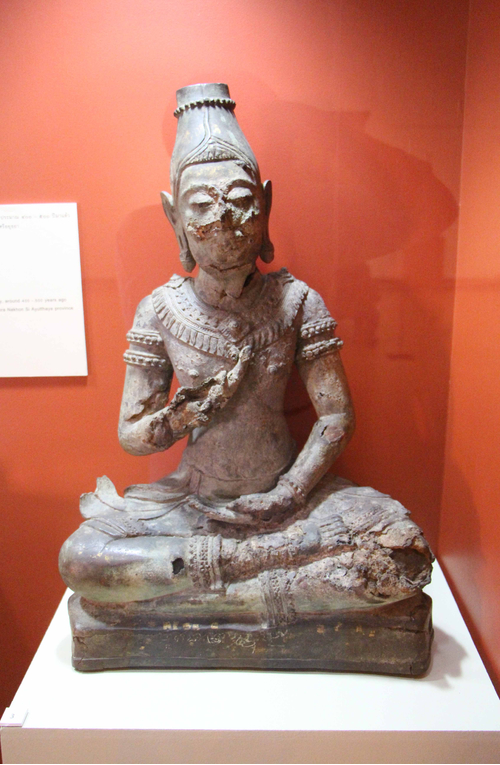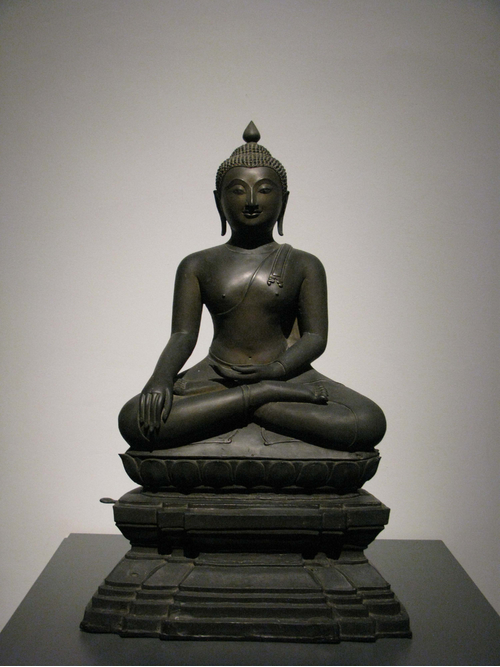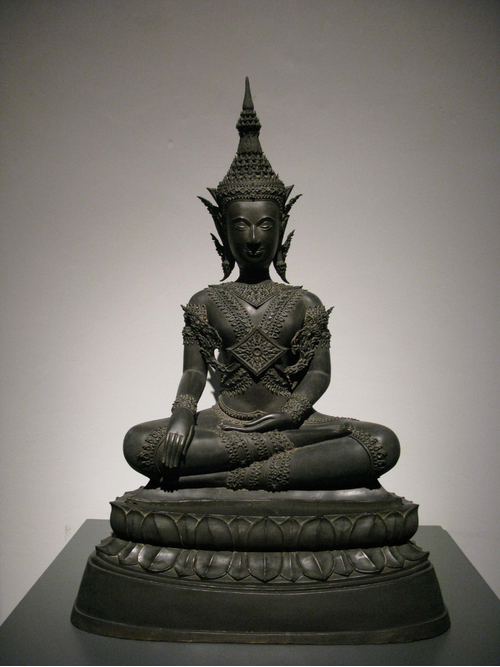ค้นหางานศิลปกรรม
ฐานข้อมูลศิลปกรรมในเอเชียตะวันออกเฉียงใต้
ประติมากรรมพระพุทธรูปปางสมาธิ
พระพุทธรูปนั่งขัดสมาธิราบแบบหลวม ซ้อนกันเฉพาะพระบาท พระหัตถ์แสดงปางสมาธิ พระพักตร์เหลี่ยม พระขนงนูนเป็นสันและต่อกันเป็นปีกกา พระเนตรเหลือบต่ำและโปน พระนาสิกใหญ่ พระโอษฐ์แบะและกว้าง พระอุษณีษะเป็นต่อมนูนสูง มีพระรัศมีรูปดอกบัวตูมหรือลูกแก้ววางเหนือพระอุษณีษะ ครองจีวรห่มเฉียง เรียบไม่มีริ้ว บางแนบพระวรกาย
ประติมากรรมภาพสลักเล่าเรื่องยมกปาฏิหาริย์
แผ่นหินนี้สลักภาพเล่าเรื่องพุทธประวัติตอนแสดงยมกปาฏิหาริย์ที่เมืองสาวัตถีเพื่อปราบเหล่าเดียรถีย์ พระพุทธเจ้านั่งห้อยพระบาทบนบัลลังก์ซึ่งวางอยู่ใต้ต้นมะม่วง พระหัตถ์ขวาแสดงปางประทานธรรมทั้งสองข้างแวดล้อมด้วยภาพบุคคลจำนวนมาก แต่ละข้างมีเส้นตรงตามแนวนอนแบ่งกลุ่มบุคคลออกเป็น 2 กลุ่ม น่าจะสื่อว่าใต้เส้นตรงเป็นโลกมนุษย์ เหนือเส้นตรงเป็นสวรรค์ ดังนั้นกลุ่มบุคคลใต้แนวเส้นตรงที่อยู่ทางขวาของพระพุทธองค์น่าจะหมายถึงพระเจ้าปเสนทิโกศลพร้อมด้วยผู้ติดตาม ในขณะที่อีกข้างหนึ่งใต้แนวเส้นตรงเป็นเหล่าเดียรถีย์ที่พ่ายแพ้ สำหรับบุคคลที่อยู่เหนือแนวเส้นตรงเป็นทิพยบุคคลบนสวรรค์ โดยด้านขวาของพระพุทธองค์เป็นบุคคลสวมเครื่องทรงจำนวนมากน่าจะเป็นเทวดาที่นำโดยพระอินทร์ ส่วนด้านซ้ายเป็นบุคคลที่ครองเพศนักบวชน่าจะเป็นพระพรหม ถัดขึ้นไปด้านบนตามกิ่งก้านของต้นมะม่วงปรากฏภาพพระพุทธนิรมิตในอิริยาบถต่างๆ 7 องค์
ประติมากรรมพระพุทธรูป
พระพุทธรูปยืนทำปางแสดงธรรม แม้ว่าพระหัตถ์ซ้ายจะชำรุดแต่เชื่อได้ว่าทำปางแสดงธรรมเหมือนกันกับพระหัตถ์ขวา ครองจีวรห่มคลุม เรียบไม่มีริ้ว บางแนบพระวรกาย ชายจีวรเบื้องล่างด้านหน้าพาดผ่านพระชงฆ์เป็นรูปวงโค้ง ส่วนชายจีวรเบื้องล่างด้านข้างผายออกด้านนอก เป็นลักษณะที่พบได้ในพระพุทธรูปทวารวดีอีสาน พระพักตร์ค่อนข้างเหลี่ยม มีพระอุณาโลมกลางพระนลาฏ พระขนงนูนเป็นสันและต่อกันเป็นปีกกา พระเนตรเหลือบต่ำและโปน พระนาสิกใหญ่ พระโอษฐ์แบะและกว้าง พระอุษณีษะเป็นต่อมนูนสูง
ประติมากรรมพระพุทธรูปนาคปรก
พระพุทธรูปนูนสูงองค์นี้ทำเป็นปางนาคปรก พระพุทธองค์นั่งทำปางสมาธิอยู่เหนือขนดนาค ครองจีวรห่มเฉียง เรียบ บางแนบเนื้อ มีชายจีวรอยู่เหนือพระอังสาขวา นาคมี 7 เศียร ปกอยู่เหนือพระเศียรของพระพุทธเจ้า ใบหน้าละม้ายคล้ายลิงอันเป็นลักษณะเด่นของนาคแบบทวารวดี สองข้างของพระพุทธรูปสลักรูปเจดีย์ทรงกลมข้างละ 1 องค์ ถัดลงมาเบื้องล่างของเจดีย์มีรูปบุคคลนั่งเทินอยู่ ด้านล่างสุดใต้ขนดภาคมีลายหน้าสิงห์
ประติมากรรมธรรมจักร
ธรรมจักรวงกลมประกอบด้วยส่วนสำคัญ 3 ส่วน คือ ดุมอยู่ตรงกลาง ซี่หรือกำ ระหว่างซี่แต่ละซี่เจาะทะลุทำให้ธรรมจักรแลดูโปร่งนอกสุดเป็นกงซึ่งตกแต่งด้วยลายดอกไม้กลมสลับกับสี่เหลี่ยมขนมเปียกปูน ขอบกงมีลวดลายกนกคล้ายเปลวไฟ ส่วนล่างมีแผงสามเหลี่ยมรับน้ำหนักต่อเนื่องไปยังแท่นฐานสี่เหลี่ยมที่รับองค์ธรรมจักรไว้ตามตำแหน่งต่างๆ ของธรรมจักรองค์นี้มีจารึกข้อพระธรรมภาษาบาลี อักษรปัลลวะ เป็นข้อความจากธรรมจักรกัปปวัตรสูตร
ประติมากรรมพระโพธิสัตว์
พระโพธิสัตว์นั่งขัดสมาธิราบบนฐานหน้ากระดานที่มีจารึก พระหัตถ์ขวาชำรุดทราบแต่เพียงยกขึ้นระดับพระอุระ พระหัตถ์ซ้ายวางเหนือพระเพลา พระเกศายาวเกล้าเป็นมวยดังนักบวช สวมเครื่องทรงต่างๆ อาทิ กรองศอ พาหุรัด ทองพระกร ทองพระบาท
ประติมากรรมพระพุทธรูปปางมารวิชัย
พระพุทธรูปนั่งขัดสมาธิเพชร พระหัตถ์ทำปางมารวิชัย รองรับด้วยฐานกลีบบัวหงายและชุดฐานบัวยกเก็จ รูปแบบโดยรวมสะท้อนแรงบันดาลใจจากพระพุทธรูปล้านนาแบบสิงห์หนึ่ง ลักษณะเด่นได้แก่ พระพักตร์กลม พระรัศมีรูปดอกบัวตูม พระวรกายอวบอ้วน ครองจีวรห่มเฉียง ชายสังฆาฏิขนาดเล็กพาดผ่านพระอังสาซ้าย ปลายอยู่เหนือพระถันหยักโค้งไปมา เรียกกันว่าแบบเขี้ยวตะขาบ
ประติมากรรมพระพุทธรูปทรงเครื่อง
พระพุทธรูปขัดสมาธิราบ พระหัตถ์ทำปางมารวิชัย รองรับด้วยฐานบัว สวมเครื่องปะดับจำนวนมากนิยมเรียกกันว่าพระทรงเครื่องใหญ่ พระเศียรทรงมงกุฏ ประดับกรรเจียกจร พระกุณฑลทรงตุ้มแหลม พระวรกายประดับด้วยกรองศอ ทับทรวง และสังวาล พระพาหาประดับพาหุรัด และมีกำไลข้อพระกร กำไลข้อพระบาท
